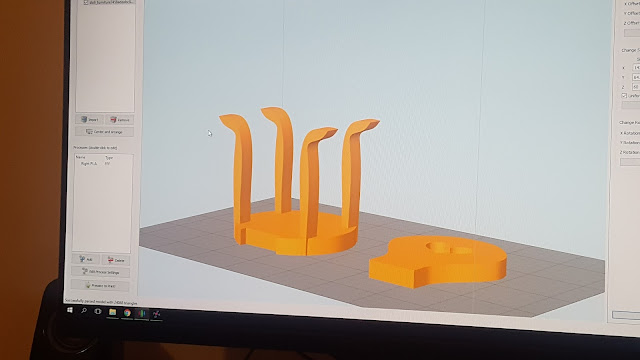Once I'd finished the flooring of the set, I began to work on the boards. I wanted the set to give the look of a cabin a it was the bear's home in the story. I used a foam board and stuck kitchen towel to the surface and began to paint with watercolours.
Once the watercolours had dried, I then began to work back into the wallpaper with a darker colour to add a sense of depth to the set.
I had to repeat this process three times over to have a three wall set, allowing the movement for the puppets to come from the exposed wall where the camera would be. I didn't want to allow space for a trap door as the set was quite low and I'd already tested the movement with my first armature.
As the set was beginning to take form, I began to consider the furnishings inside the set, this worked really well and I was lucky enough to be able to 3D print some of the furniture for it. I found a few chairs, a TV and a table from a 3D printing website and changed the measurements to fit with my set.
When they had finished printing I painted them a brown-wood colour to blend with the rest of the set. This was so it maintained the cabin like feel I had originally wanted.
The 3D printed chair seemed to fit really well with the storyline and the colours worked well with my original colour theory and the colours of the set.
Additionally to the 3D printed furniture, I wanted to make some from the foam boards I had used for the walls in the set. The only problems I encountered with using the foam boards was the fact that the paper used to conceal the board underneath doesn't come off very well. This made it harder to indent the surface with a wood-like texture.
However, I did manage to give the appeal of wood by making sure I had shaded the areas that would give that type of texture.
I also began to add tiny details such as the curtains, frames for the walls, shelves, books and a porridge jar to set the scene for the bears.
Once all of the finishing touches had been made for the set, I began to assemble the walls to the floor. This part was probably the hardest in terms of making sure that I wasn't being too forceful with the foam boards so they didn't warp.
After seeing what the set looked like, I wanted to hide the seams in the corners of the set. Therefore, I decided to create a skirting that ran up the wall and an old victorian coving.
I then began to experiment with the furniture being in different places so the composition of the scene would never include the character having his/her back to the camera.





































